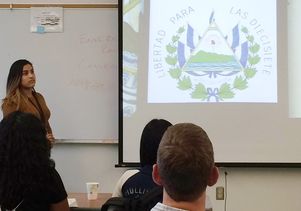As a renowned authority on how global cultures are interfacing with new technology, Ramesh Srinivasan has led collaborative research projects with communities in Egypt, rural India, Bolivia and Native American tribal lands, looking at how new media technologies influence — and are influenced by — social, cultural, economic and political dynamics.
But recently the UCLA associate professor of information studies worked with a different population closer to home to explore how digital technologies can be used as a means of expression and representation in the fight for social and environmental justice and inclusion.
Srinivasan and members of the UCLA Digital Cultures Lab, a systemwide network of scholars, students and staff that he founded last spring, held their first public event in partnership with Augustus F. Hawkins High School in South Los Angeles.

An interdisciplinary team of UC faculty and high school teachers led three workshops with small groups of high school students to explore the intersection of digital media and youth activism involving such issues as reclaiming parks, police brutality, developing local businesses and #blacklivesmatter. For example, using digital art tools, students created a logo protesting the stringent anti-abortion laws in El Salvador that resulted in the incarceration of 17 women whose only “crime” was that they had miscarried. Students also learned how to turn thoughtful research and political engagement into compelling narrative data graphics using different publishing platforms.
In another workshop, students created a 3-D cyber mural to learn how language and cognition, combined with technology and art, can become a valuable resource in response to social and environmental crises.
Srinivasan says that bringing these workshops to high school students enriches both student learning as well as the research experience of his UC colleagues in profound ways.
“The vast majority of technologies are designed not necessarily for the global, cross-cultural populations that have come to collide with these technologies in recent years,” he explained. “So, instead of assuming that technologies should be created or understood in a one-size-fits-all manner, we are all about a collaborative approach toward rethinking how technologies are created, whom they serve and how one would develop a project that is mutually beneficial and supportive of communities that are [unique] worlds in their own right.”
This was the first of several workshops to be held — potentially in South L.A. — that will build partnerships among UC scholars and researchers and LAUSD teachers and students who are interested in new media’s role in activism, education and civic engagement. The event was sponsored by the Michelson 20MM Foundation (formerly Twenty Million Minds).
South Los Angeles high schools, like Augustus F. Hawkins, are ideal venues for the lab’s collaborations since teachers there already have expertise in utilizing digital tools in a social justice and educational context, said Ung-Sang Lee, a Ph.D. student in the UCLA Division of Urban Schooling and the coordinator of the UCLA Digital Cultures Lab.
“My research is around how [underrepresented] students’ voices could be privileged around technology,” says Lee, who has established a student group at a Los Angeles high school that uses technology. “The people involved our lab really care about how broader trends in the world of technology play out in real-life contexts.”
Srinivasan says that high school students, particularly in regions such as South Los Angeles that have been historically marginalized, are a key age group from which the lab can draw rich data on grassroots social change.
“Part of what was really powerful at our workshops was our realization that these youth are already incredibly empowered,” Srinivasan says. “They have a great amount of passion, ambition and creativity.” And they are already thinking about ways to use technology for social action, he adds.
“Youth have the tools and creativity. How they put them together, not just in collaboration with UC faculty but with their own teachers, provides a great amount of energy, hope and inspiration,” Srinivasan says. “They really have the potential to take leadership over collaborations and technology projects we can develop within the UCLA Digital Cultures Lab.”
This story was adapted from one posted on Ampersand, the online magazine of the UCLA Graduate School of Education and Information Studies. Read the complete story here.





